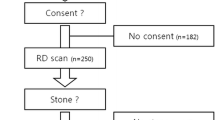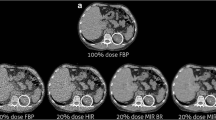Abstract
Purpose
To compare radiation dose and image quality in regular, low, and ultralow-dose CT protocols, and to evaluate diagnostic performance of low-dose CT for urolithiasis.
Materials and methods
Sixty-five patients with suspected urolithiasis underwent three different scans under the regular, low, and ultralow-dose protocols. The regular dose scans were reconstructed using filtered back projection and the low-dose scans were reconstructed using a statistical iterative reconstruction. The ultralow-dose scans were reconstructed using both techniques in addition to a knowledge-based IR. Effective radiation doses were compared. Objective image noise was assessed by measuring standard deviation of HU and subjective image assessment was performed with a 3- or 5-point scale. Diagnostic performance of the low-dose image was evaluated, using the regular dose image as a standard reference and the interobserver agreement between two reviewers with different levels of experience was calculated.
Results
The effective radiation dose was significantly different in each protocol (p < 0.001) and estimated dose reduction of the low-dose and ultralow-dose protocols was 76.4% and 89.8%, respectively. The knowledge-based iterative reconstruction algorithm showed poorer subjective image quality than the regular and low-dose protocols, but it also had the least objective image noise. Overall, the low-dose image set showed a greater than 84% concordance rate and 100% in ureter stones larger than 3 mm. Interobserver agreement was substantial (kappa value = 0.61).
Conclusions
The knowledge-based IR can provide a better quality image while reducing radiation exposure under the same protocol. Furthermore, the diagnostic performance of the low-dose CT protocol is comparable to the regular dose scan.







Similar content being viewed by others
References
Youn JH, Kim SS, Yu JH, et al. (2012) Efficacy and safety of emergency ureteroscopic management of ureteral calculi. Korean J Urol 53:632–635
Preminger GM, Tiselius HG, Assimos DG, et al. (2007) 2007 guideline for the management of ureteral calculi. J Urol 178:2418–2434
Türk C, Knoll T, Petrik A, et al. (2010) Guidelines on Urolithiasis EAU Guidelines, edition presented at the 25th EAU Annual Congress, Barcelona
Huang WY, Chen YF, Chen SC, et al. (2012) Pediatric urolithiasis in Taiwan: a nationwide study, 1997-2006. Urology 79:1355–1359
VanDervoort K, Wiesen J, Frank R, et al. (2007) Urolithiasis in pediatric patients: a single center study of incidence, clinical presentation and outcome. J Urol 177:2300–2305
Scales CD Jr, Curtis LH, Norris RD, et al. (2007) Changing gender prevalence of stone disease. J Urol 177:979–982
Stamatelou KK, Francis ME, Jones CA, et al. (2003) Time trends in reported prevalence of kidney stones in the United States: 1976-1994. Kidney Int 63:1817–1823
Boulay I, Holtz P, Foley WD, et al. (1999) Ureteral calculi: diagnostic efficacy of helical CT and implications for treatment of patients. Am J Roentgenol 172:1485–1490
Vieweg J, Teh C, Freed K, et al. (1998) Unenhanced helical computerized tomography for the evaluation of patients with acute flank pain. J Urol 160:679–684
Smith RC, Rosenfield AT, Choe KA, et al. (1995) Acute flank pain: comparison of non-contrast-enhanced CT and intravenous urography. Radiology 194:789–794
Mettler FA Jr, Bhargavan M, Faulkner K, et al. (2009) Radiologic and nuclear medicine studies in the United States and worldwide: frequency, radiation dose, and comparison with other radiation sources—1950-2007. Radiology 253:520–531
Costello JE, Cecava ND, Tucker JE, Bau JL (2013) CT radiation dose: current controversies and dose reduction strategies. Am J Roentgenol 201:1283–1290
Kulkarni NM, Uppot RN, Eisner BH, Sahani DV (2012) Radiation dose reduction at multidetector CT with adaptive statistical iterative reconstruction for evaluation of urolithiasis: how low can we go? Radiology 265:158–166
Ibrahim M, Parmar H, Christodoulou E, Mukherji S (2014) Raise the bar and lower the dose: current and future strategies for radiation dose reduction in head and neck imaging. Am J Neuroradiol 35:619–624
Love A, Olsson ML, Siemund R, et al. (2013) Six iterative reconstruction algorithms in brain CT: a phantom study on image quality at different radiation dose levels. Br J Radiol 86:20130388
Deak PD, Smal Y, Kalender WA (2010) Multisection CT protocols: sex- and age-specific conversion factors used to determine effective dose from dose-length product. Radiology 257:158–166
Neisius A, Wang AJ, Wang C, et al. (2013) Radiation exposure in urology: a genitourinary catalogue for diagnostic imaging. J Urol 190:2117–2123
Niemann T, Kollmann T, Bongartz G (2008) Diagnostic performance of low-dose CT for the detection of urolithiasis: a meta-analysis. Am J Roentgenol 191:396–401
Mettler FA Jr, Huda W, Yoshizumi TT, Mahesh M (2008) Effective doses in radiology and diagnostic nuclear medicine: a catalog. Radiology 248:254–263
Ferrandino MN, Bagrodia A, Pierre SA, et al. (2009) Radiation exposure in the acute and short-term management of urolithiasis at 2 academic centers. J Urol 181:668–672; discussion 673
Pickhardt PJ, Lubner MG, Kim DH, et al. (2012) Abdominal CT with model-based iterative reconstruction (MBIR): initial results of a prospective trial comparing ultralow-dose with standard-dose imaging. Am J Roentgenol 199:1266–1274
Singh S, Kalra MK, Do S, et al. (2012) Comparison of hybrid and pure iterative reconstruction techniques with conventional filtered back projection: dose reduction potential in the abdomen. J Comput Assist Tomogr 36:347–353
Deak Z, Grimm JM, Treitl M, et al. (2013) Filtered back projection, adaptive statistical iterative reconstruction, and a model-based iterative reconstruction in abdominal CT: an experimental clinical study. Radiology 266:197–206
Vardhanabhuti V, Ilyas S, Gutteridge C, et al. (2013) Comparison of image quality between filtered back-projection and the adaptive statistical and novel model-based iterative reconstruction techniques in abdominal CT for renal calculi. Insights Imaging 4:661–669
Fleischmann D, Boas FE (2011) Computed tomography–old ideas and new technology. Eur Radiol 21:510–517
Nelson RC, Feuerlein S, Boll DT (2011) New iterative reconstruction techniques for cardiovascular computed tomography: how do they work, and what are the advantages and disadvantages? J Cardiovasc Comput Tomogr 5:286–292
Mehta D, Thompson R, et al. (2013) Iterative model reconstruction: simultaneously lowered computed tomography radiation dose and improved image qulity. Med Phys Int J 1:147–155
Acknowledgments
We appreciate the assistance of Philips Healthcare by providing the knowledge-based IR, IMR prototype. We also appreciate the assistance in working the study of Young Mi Chun (Philips Healthcare) and Chul Lee, RT.
Author information
Authors and Affiliations
Corresponding author
Rights and permissions
About this article
Cite this article
Hur, J., Park, S.B., Lee, J.B. et al. CT for evaluation of urolithiasis: image quality of ultralow-dose (Sub mSv) CT with knowledge-based iterative reconstruction and diagnostic performance of low-dose CT with statistical iterative reconstruction. Abdom Imaging 40, 2432–2440 (2015). https://doi.org/10.1007/s00261-015-0411-2
Published:
Issue Date:
DOI: https://doi.org/10.1007/s00261-015-0411-2




